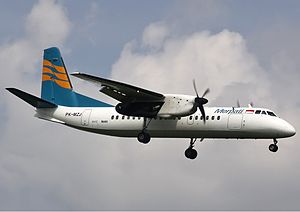Crash: Merpati MA60 at Kaimana on May 7th 2011, impacted waters before runway
By Simon Hradecky, created Monday, May 7th 2012 13:57Z, last updated Monday, May 7th 2012 13:57Z
Indonesia's NTSC released their final report concluding the probable cause of the crash was:
- The flight was conducted in VFR in condition that was not suitable for visual approach when the visibility was 2 km. In such a situation a visual approach should not have been attempted.
- There was no checklist reading and crew briefing.
- The flight crew had lack of situation awareness when tried to find the runway, and discontinued the approach.
- The missed approach was initiated at altitude 376 feet pressure altitude (250 feet radio altitude), the pilot open power to 70% and 82% torque followed by flap retracted to 5 and subsequently to 0. The rapid descent was mainly caused by continuously increase of roll angle up to 38 degree to the left and the retraction of flaps from 15 to 0 position.
- Both crew had low experience/flying time on type.
- Inadequacy/ineffectivity in the training program may lead to actions that deviated from the standard procedure and regression to the previous type.
The captain (55, ATPL, 24,470 hours total, 199 hours on type) was pilot monitoring, the first officer (36, CPL, 370 hours total, 234 hours on type) was pilot flying.
During the approach to Kaimana the cockpit voice recorder did not record any crew briefing nor did it record any checklist reading. This resulted in the engine regime remaining in cruise mode, which seriously limited the engine torque and impaired the performance of the aircraft during the later go-around, where engines reached 82% instead of 95% torque. As a further result the crew was not in synchronisation with their plans for the approach.
Following the last communication with the Kaimana flight information service, in which AFIS reported the visibility was still 2000 meters and it was raining, the crew continued the approach south of the aerodrome with the intention to attempt a visual approach.
During the turn to final the captain took control of the aircraft, the investigation was not able to determine why that change of crew roles occurred in this critical phase of the flight which possibly increased the work load of the crew. The autopilot was disengaged when the aircraft descended through 960 feet MSL. About 17 seconds after the captain took control of the aircraft the EGPWS announced "Minimum, Minimum" at 580 feet MSL (456 feet AGL), the approach at that point was not stabilized, which should have prompted the crew to go around.
The captain queried the first officer several times whether he could see the runway, the first officer replied he could not see the runway.
At 376 feet MSL the captain decided to discontinue the approach, increased engine power, initated a turn to the left and initiated a climb, the flaps were retracted from 15 to 5 and landing gear was retracted, the flaps retraction in contradiction to requirements by the flight crew operating manual which required flaps 15 to be maintained until above 400 feet AGL and above 135 KIAS.
The aircraft reached 585 feet MSL at 124 KIAS and 1.8 degrees nose down attitude. The aircraft rolled left continuously until reaching 38 degrees while descending through 482 feet MSL, the flaps were retracted from 5 to 0 degrees, the rate of descent increased to 3000 feet per minute and impacted the shallow sea. The main wreckage came to rest at position S3.6522 E133.6875. All 25 occupants perished in the crash.
A ground witness phoned Kaimana's flight information service, the officer could not see the crash site because it was blocked by trees. The NTSB added: "There were four personnel of the airport rescue and fire fighting deployed to the coastline near the beginning of Runway 01, followed by one ambulance, eight security personnel and ten airport personnel."
The NTSC annotated that the captain's calls and behaviour suggested that he may have reverted to procedures for his former aircraft type, a Fokker 100, which he had flown for 6,982 hours and where flaps 5 was typical for a go-around.
The NTSC analysed that the crew pairing was in contradiction to safety recommendations, both crew were below 250 hours of experience on the accident aircraft type which such may have contributed to the accident.
The NTSB summarized their analysis: "The investigation determined that the aircraft was being flown under visual flight in condition that was not suitable for a visual approach. The crew did not follow standard operating procedures and did not conduct an approach briefing or complete the landing checklist.
The crew were continually seeking to establish visual reference with the runway but were unsuccessful. Following the decision to discontinue the approach, the PIC deviated from the standard go-around procedures while the aircraft was in close proximity to the water.
The rapid descent was mainly a result of a combination of situations such as high bank angle (up to 38 deg to the left) and the flaps retracted to 5 and subsequently to 0 position, and also the combination of other situations such as; engine torque, airspeed, and nose-down pitch."
Aerial overview of the crash site (Photo: NTSC):
Flight trajectory (Graphics NTSC):
Graphics representation of flight data (Graphics NTSC):

